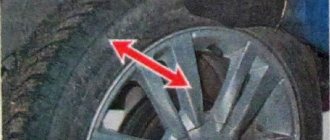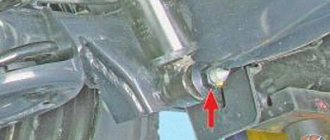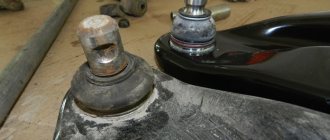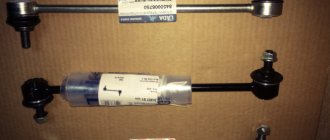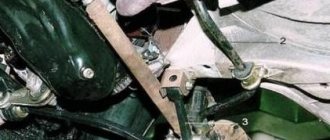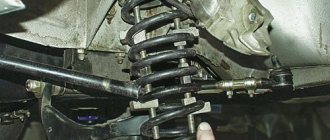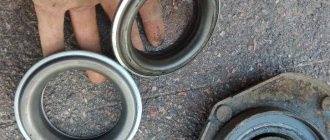Which shock absorbers are better to install on Lada Vesta
The main task of shock absorbers is to keep the wheel in constant contact with the road to avoid loss of control over the car.
Currently, Vesta offers a large variety of shock absorbers from different manufacturers. Let's figure out which shock absorbers are better to choose: original or analogue. Article numbers of original Lada Vesta front suspension parts
:
- 8450006745 and 8450006744 — Telescopic stand left and right assembled (SAAZ)
- 8450031057 (8450033433) and 8450031056 (8450033432) — Telescopic stand left and right assembled Cross (LADA Izhevsk)
- 8450032654 and 8450032653- Telescopic stand left and right assembly Sport (Lada-Sport)
- 8450033433 (8450031057) and 8450033432 (8450031056) — Telescopic stand left and right assembled Cross (SAAZ)
Article numbers of original Lada Vesta rear suspension parts
:
- 8450006786 — Rear suspension shock absorber assembly (SAAZ)
- 8450031059 — Shock absorber rear suspension assembly Cross (LADA Izhevsk)
- 8450032657 — Shock absorber rear suspension assembly Sport (Lada-Sport)
Every shock absorber manufacturer claims that their products are superior to OEM parts. For example:
- more comfortable and smooth passage of small and large road irregularities;
- more reinforced shock absorber design;
- ability to select the level of hardness;
- lowering suspension kit;
- etc.
This allows Vest owners to choose shock absorbers that best suit their specific driving style.
Determined by voting
:
- Which brand of shock absorbers did you choose?
- What is more important to you: comfort or controllability?
- What was the service life of the factory shock absorbers?
Leave your feedback in the comments, take part in the survey!
Source
How to choose the right analogue
Replacing a shock absorber begins with its selection and purchase. To choose the right part, you should take into account the quality of the road surface. For rough roads, experienced drivers recommend installing soft shock absorbers. The plush suspension compensates for road unevenness and improves ride comfort. The downside is loss of stability at high speeds. If the road is good, you can install extremely tight racks. This will help increase the machine's operating speeds and minimize roll in turns, reducing sideways pulls.
Features of Vesta car shock absorbers
The front shock absorbers have the appearance of classic MacPherson struts and have the following characteristics:
| Catalog number | 8450006745 (left) |
| Shock absorber type | Gas |
| Bottom mount | Eyelet + rubber-metal joint |
| Top mount | Stock |
| Rod diameter | 20 mm |
| Case diameter | 48.5 mm |
A special feature of the rear shock absorbers is their separate location from the springs. These are double-sided gas shock absorbers, which differ from other VAZ models in their size.
| Catalog number | 2180-2915402 |
| Shock absorber type | Gas |
| Axle (installation side) | Rear, right, left |
| Bottom mount | Eyelet + rubber-metal hinge |
| Top mount | Stock |
| Rod thread parameters | M10x1.25 |
| Connection length 2 | 602±3 mm |
| Connection length 1 | 375±3 mm |
| Rod diameter | 12.5 mm |
| Casing diameter | 47 mm |
| Rod stroke | 237 mm |
Front struts
The chassis of the car has excellent shock absorbers. The right and left differ in some respects, although they have identical dimensions. Each of them has its own article number. If you need to replace the front struts of the Lada Vesta, you can look for original parts, or use analogues from other manufacturers. Among the proposed analog models there are options with a greater or lesser degree of noise in operation. Drivers trying to get rid of excessive noise should take this indicator into account when choosing a new part.
Manufacturers you can pay attention to:
- stellox;
- trialli;
- finwhale;
- SS-20;
- Asomi;
- Demfi.
How do you know if a shock absorber has failed?
The first sign of a damaged rack will be discomfort when hitting an obstacle.
The lack of proper shock absorption is very noticeable in the cabin. The following signs will help you suspect a malfunction:
- Unusual sounds from the suspension. They may be constant or occur only during off-road driving;
- The car's controllability has decreased, the car skids and sways from side to side.
- The ground clearance has decreased (the car has sank).
- If the shock absorbers are oil or gas oil, they may leak. The appearance of drips on the racks indicates that they need to be replaced. The leakage of gas struts can be determined by the characteristic hissing sound made by the gas escaping from them.
If you have such problems, you need to contact a service station, where they will carry out diagnostics and find out the causes of the problem. If you have a suitable location and the necessary equipment, you can inspect and identify the problem yourself.
How to change struts on Vesta correctly
Initially, most car enthusiasts change suspension parts as they wear out. So, a replacement for the damaged element is purchased and the car is repaired. Perhaps in most units such actions are justified. When working with shock absorber struts, this sequence can cause more harm than savings.
Experienced craftsmen insist that the racks must be changed at least in pairs. This will help avoid increasing the load on the new part after its installation. Also, installing parts as a kit allows you to save time and money when visiting a service station.
Cost of shock absorbers for Lada Vesta
Many drivers are interested in the question, what shock absorbers are installed on Vesta from the factory? According to information from official sources, Lada Vesta cars of all modifications are equipped with Russian-made parts. They are manufactured by the Russian company SAAZ (Skopinsky Automotive Aggregate Plant), specially commissioned by AvtoVAZ. These racks are adapted for difficult road conditions and have proven themselves in practice.
If replacement is necessary, the driver can purchase original spare parts that are commercially available. You can also use analogues, which are also widely available on the shelves of auto stores. The cost of shock absorbers from different manufacturers is presented in the following table:
Cost (front/rear)
| Manufacturer | vendor code | ||
| Demfi (Russia, Skopino) | SFC8012 | SRC8012 | |
| SS20 (Russia) | OEM 8450006744 and 8450006745 | OEM 8450006786 | 6490 RUR/2 pcs. |
| Finwhale (Germany) | 13081GR | ||
| Trialli (Russia, Türkiye) | AG1365 | ||
| Pilenga (Italy) | SH-P2712G | 2300 rub/piece | |
| Stellox Germany (produced in Macedonia, Turkey, Poland) | 4214-0108-SX *Prices are valid as of August 2022 | ||
Replacing stabilizer struts for Lada Vesta SV Cross
The procedure for replacing shock absorber struts on the rear of the car and the front is slightly different. What is common is the set of tools and the procedure for preparing the machine.
Necessary tool
Replacing Lada Vesta struts requires the following tools:
- set of Phillips and flat head screwdrivers;
- set of open-end wrenches;
- metal brush;
- special wrench for wheel bolts;
- Torx in size T30;
- Jack or special lift.
You will also need a certain amount of rags and penetrating lubricant or its equivalent.
Front of the car
On a Lada Vesta, replacing stabilizer struts with your own hands is done like this.
- It is good to wash the car and the suspension in particular - it is much easier to work with clean surfaces.
- Remove the mounting bolts for the required wheel and loosen them.
- Raise the car on a jack or special lift.
- Prepare all tools for ease of access and work.
- Completely unscrew the wheel and remove it from the vehicle.
- The next step is to hang the car so that the front wheels are hanging in the air.
- Next, you will need to unscrew the stabilizer link from the shock absorber, as shown in the figure.
- Next, you need to disconnect the speed sensor and unscrew the lower nut securing the strut to the steering knuckle.
- After this, the part can be completely removed from the machine and replaced with a new one.
- Reassembling the suspension units is performed in the reverse order.
After assembly, check the tightness of all bolts with a torque wrench. An important parameter for stable operation of the suspension is correct tightening.
Also, experienced craftsmen recommend using only the nuts supplied with the part.
Rear part of the car
Replacing the rear struts of a Lada Vesta is slightly different in technology and sequence of actions. The above tools are also used here, but the repair itself has its own specifics.
Sequencing
On the Lada Vesta, replacing the rear shock absorber struts is much simplified compared to the procedure performed on older modifications of the car. here the shock absorbers are installed separately from the springs, which makes the work of the craftsmen easier. There is also no need for a partner; now there is no need to hold the internal bolts of the upper fastening.
- To begin, the car should be raised on a jack or lift and the terminal removed from the battery.
- Unscrew the wheels and remove them from the car.
- Next, you will need to place special supports under the suspension parts and lower the car until the spring begins to compress. This will relieve the tension in the suspension device.
- The replacement of the stabilizer struts of the Lada Vesta SV Cross continues by unscrewing the lower hinge securing the shock absorber to the car. To do this, use a wrench of the appropriate size to unscrew the bolt and remove it from the seat.
- The vehicle can then be raised again to improve access to the rack.
- The last step is to unscrew the top mount, and the part is completely removed from the car. The stand itself is quite heavy and should be supported during dismantling.
- Installation of a new part is carried out in reverse order.
Important! Assembling the car suspension is carried out exclusively with a torque wrench. After a run of 500 - 600 kilometers, all bolts should be tightened.
Separately, it should be noted that replacing the struts of the Lada Vesta SV Cross is carried out according to a similar principle. The structure of the components on the cars is almost identical, only the length of the shock absorbers and springs differ.
Reviews and recommendations from Lada Vesta owners
Positive
NegativeWith a mileage of 38 thousand, strange sounds began to arise from the front suspension. It turned out that the racks were rattling and had already exhausted their service life. I decided to replace the original shock absorbers with the manufacturer Acomi. After I ordered on the official website, the manager immediately called back and clarified the details. The parcel arrived in Tula in 4 days, the details are as in the picture, packed in boxes. I’ve been driving on the new shock absorbers for a month now, and so far I can’t say anything bad - they cope with unevenness and obstacles perfectly. After replacing the original front struts with Acomi ones, the car began to handle worse. With the Saazov struts, it seemed to be more confused; I always knew how the car would behave in a given situation. Now, when cornering, the car sways a little and in a strong crosswind, strange vibrations are felt. The original shock absorbers were still better.On the plus side, I note that the new struts are a little quieter and give a smoother ride.
Source
Lada Vesta do-it-yourself replacement of stabilizer struts - when to change
Clear signs that it is time to replace the racks are.
- A characteristic knocking sound from the bottom of the car when driving over bumpy terrain. This is usually a sign of a completely damaged shock absorber. If you tighten it, it is possible to destroy the suspension units and body panels of the car.
- Increased rocking and roll of the car when passing high-speed turns. If the vehicle sways or tilts strongly when turning, there is a weakening of the rack’s efficiency.
- The appearance of oily stains on the shock absorber rod or in its immediate vicinity. Despite the fact that the struts are gas-filled, there is oil in them. Leakage of lubricant from the device body indicates damage to the seal. In the event of such a breakdown, the entire device should be replaced.
- The suspension becomes “plush”. Excessive softness of the car may indirectly indicate wear of the struts. At the same time, high-quality diagnostics are required - the cause of the problem may be hidden elsewhere.
- When rocking a part of the machine with your hands, the vibrations should subside immediately after the load is removed. If the body makes more than 1-2 oscillations after rocking, the strut is damaged.
Rear shock absorber
Unlike other Lada cars on Vesta, the springs and shock absorber struts in the rear suspension were blown apart. Thus, to replace the springs, the struts do not need to be dismantled. In addition, the rear shock absorbers are mounted differently at the top point; now there is no need to hold the nuts from the interior.
You will need: remove the wheel and raise the car to a height convenient for performing work, head “16”, “21”.
Place a transmission rack type SG-1 (No. 2) under the lever (Fig. 11-1, No. 1) and lower the car until the spring begins to compress. Release the shock absorber from the rear suspension arm by removing the bolt (No. 3).
Unscrew the two upper bolts (Fig. 11-2, No. 1) securing the strut to the body. Remove the rear shock absorber assembly with compression stroke buffer and upper support.
Installation is performed in reverse order.
Let us remind you that you can study the design of the Lada Vesta suspension in more detail, as well as find out reviews about it, in this article.
Share on social networks:
Found an error? Select it and press Ctrl+Enter..
Source
Topic: Knock in front suspension.
Theme Options
Search by topic
Display
Bought in March 2022 SV Cross in February of the same year. Until November I drove 12 thousand and there were no knocks. I haven’t put on winter tires yet (by the way, Bridge Revo GZ), and on 16-size wheels. Now at low speed you can hear knocking noises from every hole. Either the Bridge is so oak, or the time has come for the racks. I lowered the pressure a little to 2.1, but to no avail. While I’m driving like this, by spring I’ll hit 15 thousand just before TO1, and we’ll see. At the same time, I’ll change shoes for my summer 17s, maybe the reason is really the oak tires.
maybe so, although it is doubtful, especially the 16th. The bridge is certainly not the softest rubber, but it is not as oaky as summer tires. In winter there are many times more small hummocks, maybe that’s why?
Rear suspension device
Even many experienced drivers sometimes underestimate the influence of the rear suspension design on the car's handling.
The behavior of the car on the track should be predictable. On a perfectly flat surface, driving comfort will depend on the angle of the front wheels. But in real conditions, the rear suspension should perform the function of steering and reduce roll when cornering. The independent multi-link suspension copes well with such tasks. But it has its “innate” disadvantages. Having weighed all the pros and cons, AvtoVAZ designers gave preference to a beam that was inexpensive in terms of cost and maintenance.
- The beam is formed by a rigid connection of two longitudinal and one transverse lever. Many sources make no mention of levers, since a single structure - a beam - has long been in the vocabulary of car enthusiasts.
- The shock absorbers and springs are separated, that is, they are not aligned. Some experts see this as an increase in the number of support points. As a result, the vehicle's stability increases. Others consider this decision to be a foundation for the future, because it is planned to release an all-wheel drive version of the Lada Vesta SW Cross.
- The drums and hubs were inherited from their predecessors. Disc brakes, of course, are much more efficient, but since the Cross version is designed for outdoor activities, dirt may get on the brake mechanism. The drum system is less demanding in this regard. There is another expert opinion, which is that the manufacturer decided to save on some components so that the cost of the new product does not reach prohibitive values.
Externally, the rear suspension design has much in common with the already classic version. And, nevertheless, West station wagons are equipped with higher springs.
- Rear suspension beam. The diagram does not show that the stabilizers are built inside the beam, since it has a U-shaped cross-section. Such stabilizers began to be installed on Priors, which favorably distinguished the new beam from the “eight” one.
- Spring insert.
- The barrel-shaped spring rests its upper part against the spar.
- Top insert.
- The shock absorber support is mounted inside the arch.
- Buffer bumper with protective boot.
- Shock absorber glass.
- Rear hub.
- Brake drum.
Differences between the suspension of Lada Vesta SW Cross and Lada Vesta SW
The concept of creating a car with the Cross emblem is not only about design transformations.
Although to its credit, the body kits, decorative trim on the muffler pipe and the stylish design of the dashboard give the impression of a more predatory temperament. This is interesting: Online store of auto parts for VAZ
But the kinetics of the car does not depend on external tuning, so Vesta still needs to earn the right to bear the Cross nickname. And the designers made some modifications to the suspension, although they did not dare experiment with the power unit.
Vesta Cross received new wheel and castor angle settings. The changed parameters made it possible to focus on the sharpness of the steering response. The normal position of the steering wheel is felt more clearly, and the car at speed quickly returns to its previous course after the maneuver. This behavior required replacing the shock absorbers. Here they are more rigid, although their type has not changed. They are gas-filled, single-acting at the front and double-acting at the rear.
The springs have also undergone changes. But trivial stretching would have the opposite effect, so the sports version uses stiffer and longer springs. All this together led to an increase in ground clearance up to 203 mm. In a regular station wagon, by comparison, this value is 178 mm.
As a result, the developers manipulated some parameters. It is known that lifting a car can cause you to lose stability. It will be possible to regain the previous performance only by making the suspension stiffer. An increase in track width by 14 mm helped find the middle ground at West Cross.
The remaining changes are common to both station wagons. We can say that the Vesta sedan took upon itself all the grief of the ordeal. The body of the stabilizer struts was changed, the shock absorber supports at the rear were made of a softer material, the rubberized parts of the support bearings and spring inserts were also modified. All this significantly reduced the number of tappings.
Rear shock absorber
Unlike other Lada cars on Vesta, the springs and shock absorber struts in the rear suspension were blown apart. Thus, to replace the springs, the struts do not need to be dismantled. In addition, the rear shock absorbers are mounted differently at the top point; now there is no need to hold the nuts from the interior.
You will need: remove the wheel and raise the car to a height convenient for performing work, head “16”, “21”.
Place a transmission rack type SG-1 (No. 2) under the lever (Fig. 11-1, No. 1) and lower the car until the spring begins to compress. Release the shock absorber from the rear suspension arm by removing the bolt (No. 3).
Unscrew the two upper bolts (Fig. 11-2, No. 1) securing the strut to the body. Remove the rear shock absorber assembly with compression stroke buffer and upper support.
Installation is performed in reverse order.
Let us remind you that you can study the design of the Lada Vesta suspension in more detail, as well as find out reviews about it, in this article.
Share on social networks:
Found an error? Select it and press Ctrl+Enter..
Source
Alternatives to standard bushings - which ones to replace with
During the repair, you can supply standard spare parts, their catalog number is 8450006748.
Stub bushings are installed on Vesta:
- length dimensions 40 mm;
- width 39 mm;
- height 45 mm;
- hole diameter 22 mm.
You can look for polyurethane ones on sale. This will turn out to be the simplest solution to the problem. The size of the front stabilizer bushing in terms of internal diameter coincides with the dimensions of the Chevrolet Niva, and the dimensions are as follows:
- length 39 mm;
- width 42 mm;
- height 43.5 mm.
The side is a little narrower, but the inner diameter fits perfectly. You will need article number 2123-2906040. This is the most common option. It is necessary to make slots on Chevrolet spare parts, like Vesta. All that remains is to grind down the sides to standard sizes and you can install them. The second option is less common among car enthusiasts. This is a replacement for consumables according to catalog 2123-2906046. The most difficult replacement option is installing analogue Lada Vesta bushings. In this case, spare parts from Kia will be suitable. Catalog number KSBSOULF-21.5 mm. (54813-2K100) Other brackets 54814-1G000 are required for them. Remember, if you use spare parts from other models, this may change the driving characteristics. The car may become a little stiffer while driving and cornering. By price, bushings can be divided into the following limits:
- Staba from 450-700 rubles;
- Niva from 150-300 rub. pair;
- Cue from 150-600 rub. thing.
